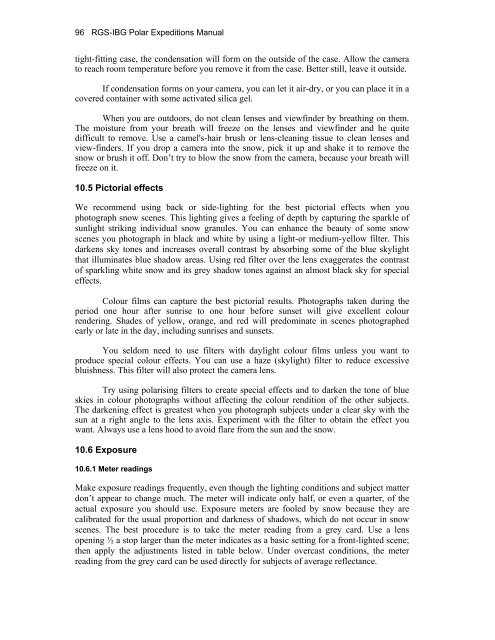Edited by Rachel Duncan 4th Edition ISBN 0-907649-91-2 London ...
Edited by Rachel Duncan 4th Edition ISBN 0-907649-91-2 London ...
Edited by Rachel Duncan 4th Edition ISBN 0-907649-91-2 London ...
Create successful ePaper yourself
Turn your PDF publications into a flip-book with our unique Google optimized e-Paper software.
96 RGS-IBG Polar Expeditions Manual<br />
tight-fitting case, the condensation will form on the outside of the case. Allow the camera<br />
to reach room temperature before you remove it from the case. Better still, leave it outside.<br />
If condensation forms on your camera, you can let it air-dry, or you can place it in a<br />
covered container with some activated silica gel.<br />
When you are outdoors, do not clean lenses and viewfinder <strong>by</strong> breathing on them.<br />
The moisture from your breath will freeze on the lenses and viewfinder and he quite<br />
difficult to remove. Use a camel's-hair brush or lens-cleaning tissue to clean lenses and<br />
view-finders. If you drop a camera into the snow, pick it up and shake it to remove the<br />
snow or brush it off. Don’t try to blow the snow from the camera, because your breath will<br />
freeze on it.<br />
10.5 Pictorial effects<br />
We recommend using back or side-lighting for the best pictorial effects when you<br />
photograph snow scenes. This lighting gives a feeling of depth <strong>by</strong> capturing the sparkle of<br />
sunlight striking individual snow granules. You can enhance the beauty of some snow<br />
scenes you photograph in black and white <strong>by</strong> using a light-or medium-yellow filter. This<br />
darkens sky tones and increases overall contrast <strong>by</strong> absorbing some of the blue skylight<br />
that illuminates blue shadow areas. Using red filter over the lens exaggerates the contrast<br />
of sparkling white snow and its grey shadow tones against an almost black sky for special<br />
effects.<br />
Colour films can capture the best pictorial results. Photographs taken during the<br />
period one hour after sunrise to one hour before sunset will give excellent colour<br />
rendering. Shades of yellow, orange, and red will predominate in scenes photographed<br />
early or late in the day, including sunrises and sunsets.<br />
You seldom need to use filters with daylight colour films unless you want to<br />
produce special colour effects. You can use a haze (skylight) filter to reduce excessive<br />
bluishness. This filter will also protect the camera lens.<br />
Try using polarising filters to create special effects and to darken the tone of blue<br />
skies in colour photographs without affecting the colour rendition of the other subjects.<br />
The darkening effect is greatest when you photograph subjects under a clear sky with the<br />
sun at a right angle to the lens axis. Experiment with the filter to obtain the effect you<br />
want. Always use a lens hood to avoid flare from the sun and the snow.<br />
10.6 Exposure<br />
10.6.1 Meter readings<br />
Make exposure readings frequently, even though the lighting conditions and subject matter<br />
don’t appear to change much. The meter will indicate only half, or even a quarter, of the<br />
actual exposure you should use. Exposure meters are fooled <strong>by</strong> snow because they are<br />
calibrated for the usual proportion and darkness of shadows, which do not occur in snow<br />
scenes. The best procedure is to take the meter reading from a grey card. Use a lens<br />
opening ½ a stop larger than the meter indicates as a basic setting for a front-lighted scene;<br />
then apply the adjustments listed in table below. Under overcast conditions, the meter<br />
reading from the grey card can be used directly for subjects of average reflectance.

















